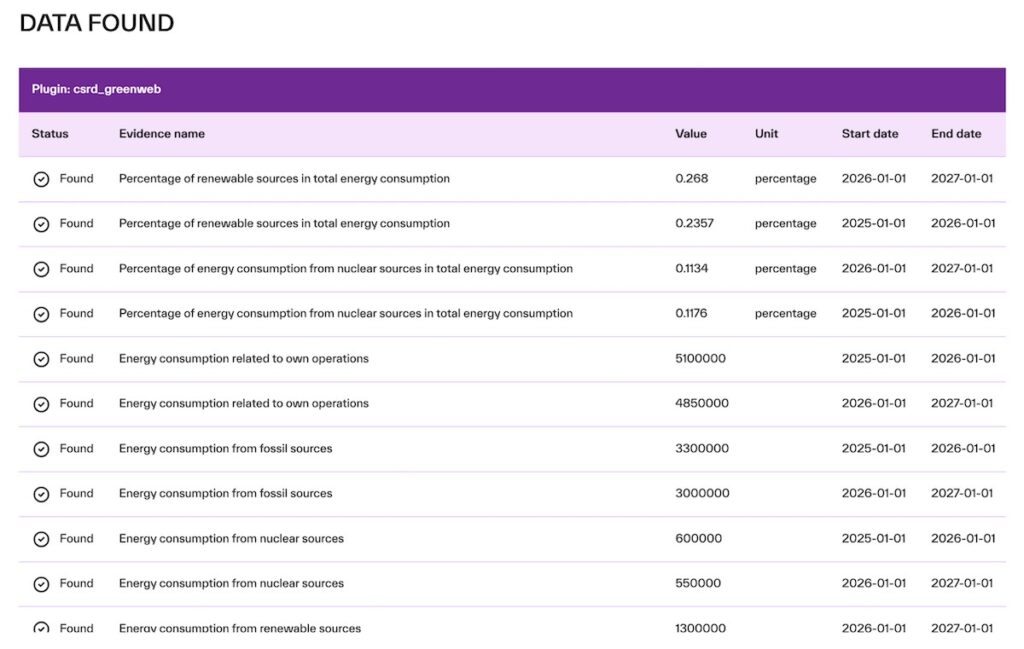In this post we explain how our latest project, carbon.txt, can be used to share Corporate Sustainability Reporting Directive (CSRD) reports and find specific sustainability data points within them. We cover the tools we built and you can use them.
“Users of sustainability information increasingly expect such information to be findable, comparable and machine-readable in digital formats. Member States should be able to require that undertakings subject to the sustainability reporting requirements of Directive 2013/34/EU make their management reports available on their websites, free of charge to the public.”
CSRD Directive (clause 55)
Addressing sustainability problems with the CSRD
The Corporate Sustainability Reporting Directive (CSRD) came into force in the European Union in January 2023. It’s part of the EU’s Green Deal, an initiative which strives for Europe to be the first climate-neutral continent. The European Commission has adopted a set of proposals to make the EU’s climate, energy, transport and taxation policies fit for reducing net greenhouse gas emissions by at least 55% by 2030, compared to 1990 levels.
CSRD requires the largest (those with more than 1000 employees) companies to publish regular reports on the social and environmental risks they face, and on how their activities impact people and the environment. This helps investors, civil society organisations, consumers and other stakeholders to evaluate the sustainability performance of companies.
What types of sustainability data are produced via the CSRD?
Companies subject to the CSRD have to report data according to European Sustainability Reporting Standards (ESRS). It mandates specific data points to include, and specific types or data to report. The standards are developed by EFRAG and consist of twelve broad categories:
- General requirements
- General disclosures
- Climate change
- Pollution
- Water and marine resources
- Biodiversity and ecosystems
- Resource use and circular economy
- Own workforce
- Workers in the value chain
- Affected communities
- Consumers and end-users
- Business conduct
Structured, machine-readable formats using XBRL
One goal for reported CSRD data is for it to be machine-readable as well, and treated with the same respect as financial data, which already has similar machine readable requirements.
“undertakings […] shall prepare their management report in the electronic reporting format […] and shall mark up their sustainability reporting, in accordance with the electronic reporting format”.
Article 29d of the Accounting Directive, as amended by the CSRD.
A specific file format is required for this data – the European Single Electronic Reporting Format (ESEF). This ESEF format enables the digital tagging of information in the reports by providing XBRL elements (or ‘tags’) for every datapoint and dimensional disaggregation defined in disclosure requirements, called XBRL taxonomies.
If you’re familiar with XML or HTML the concept is very similar. More on XBRL taxonomies.
These XBRL elements have already been defined for financial reporting, and every publicly listed company in Europe has to publish these reports annually using this ESEF file format, and the existing financial data taxonomy (the IFRS XBRL taxonomy). In August 2024, EFRAG published the first official version of a ESRS XBRL taxonomy, and 2025 is the first year that companies need to publish CSRD data with their annual management reports.
Because data is already structured in ESEF files, if you know where the file is, and there is a taxonomy defined, then you can query a single ESEF report for a data point, just like querying a database for one.
How to use carbon.txt for CRSD reports
There are lots of ways to publish something on a website. It’s only meaningful if you know where on a website to look to view the data. Therefore carbon.txt provides a pragmatic solution to making the act of sharing the data meaningful.
Carbon.txt makes it possible for anyone to share public disclosures of CSRD reports in a single known location, eg domain.com/carbon.txt.
Furthermore we have built a plugin extension to carbon.txt which can detect if a CSRD report is being shared inside a carbon.txt file, and read the XBRL data and return results for consumption elsewhere. More about the CSRD extension.
For any organisation wishing to give it a go, follow these steps:
- Create a file reporting ESRS data points* using the ESRS XBRL Taxonomy.
- Make this file available publicly in a location controlled by you.
- Build a carbon.txt file disclosing the location of your XBRL report.
- Publish your carbon.txt file at one of the recommended locations on your website.
- Validate your carbon.txt file and view the data points in a human readable format.
* Currently carbon.txt is looking for a subset of datapoints in ESRS E1 – climate change. Because the code is open source, you can see the specific data points we’re targetting – in the Python class containing them. If you follow the link you’ll see things listed like “E1-5 AR 34 – Percentage of renewable sources in total energy consumption”, and so on.
An example
What do these reports look like anyway? Some examples we’ve found combine a human readable management report with tagged ESRS XRBL data inside it.
Here’s an example of a report.
You can also put the following url – https://used-in-tests.carbontxt.org/carbon-txt-with-csrd-and-renewables.txt – into the url field of our carbon.txt validator to see how it finds and presents the data points within it.

In his personal blog, Our Director of Policy and Tech, Chris Adams, reflects on further research he’s done to uncover real management reports in the wild. He’s had some success. Who is publishing sustainability reports “the right way” in Europe now that we have the CSRD?
Recently, Maersk published their own annual management report for 2024, and it’s one of the new reports that follows the ESEF format mandated in the financial sector, and also includes content required in a CSRD report.

Chris Adams, Director of Policy & Tech – Green Web Foundation
Looking forward to the benefits
Companies above a certain size active in Europe make up the majority of its economic activity, and its carbon emissions. They already need to collate and publish information as a result of the CSRD law.
Linking to structured CSRD data inside a carbon.txt file makes it possible to realise the value of this data, by making it easier to find and easier to use.Organizations sharing their CSRD reports via a carbon.txt file demonstrate a real commitment to sustainability through being transparent and sharing data in ways others can make sense of.
At present, mandating disclosure is focussed around disclosing to a centralised portal. Or in some cases, a database that is yet to be specified, let alone built. In Europe specifically, it looks like we’ll see national databases set up for each country, that will eventually be published to a single, Europe-wide access point. It’s not clear how often updates will be made available to the public or how much it will cost to access this data programmatically. There are very good reasons to have centralised databases, but they can often be slower and less transparent than alternatives. For context, in Europe, the target timeframe for making a centralised, European-wide database available is the summer of 2027.
Structured disclosure beyond Europe
Companies are already putting the work into collecting and publishing standardised data following the guidelines in the ESRS because of the CSRD law. But this is not the only part of the world following this approach. In California and New York, new laws have been passed also requiring companies active there to publish similar kinds of structured reports online, in 2026 and 2027, respectively, and using XBRL taxonomies compatible with the ESRS.
Through using carbon.txt we think it’s possible to move faster and make disclosure more transparent than it would be with just a single centralised database in a single part of the world, because as soon as data is online, it can be discovered, and used in new ways by anyone.
Questions or need support?
If you need help making use of carbon.txt to share your sustainability data our dedicated carbon.txt website is there to help you get started.
If you can’t find what you’re looking for, or would like to explore a collaboration to build tools to scrape data disclosed in carbon.txt files, get in touch through our support form.

